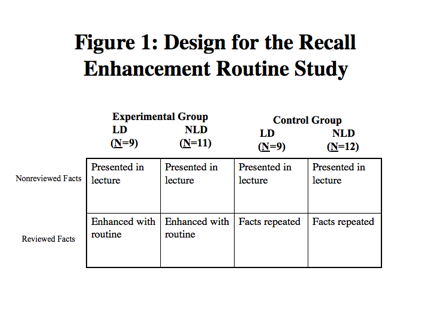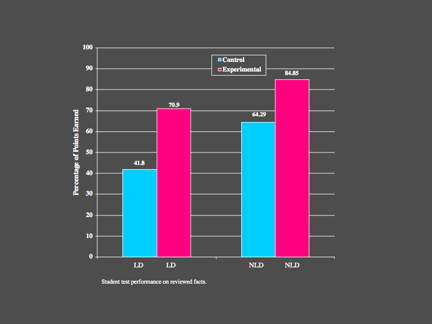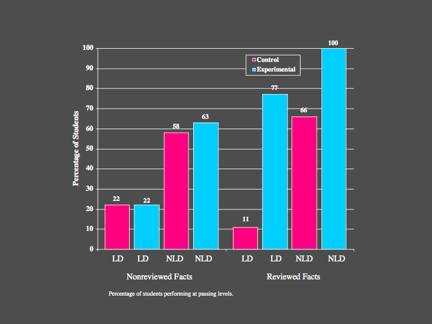Additional information
| Cover | Paperback |
|---|---|
| Dimensions (W) | 8 1/2" |
| Dimensions (H) | 11" |
| Page Count | 60 |
| Publisher | CRL |
| Year Printed | 1998 |
| Requirements |
| Cover | Paperback |
|---|---|
| Dimensions (W) | 8 1/2" |
| Dimensions (H) | 11" |
| Page Count | 60 |
| Publisher | CRL |
| Year Printed | 1998 |
| Requirements |
Study 1
Overview
The Recall Enhancement Routine is used by a teacher to help students remember important information. Forty-one students in the 7th and 8th grades participated. They were stratified by grade level and condition (students with learning disabilities [LD] and without LD [NLD]) and randomly assigned to an experimental or control group. The experimental design is shown in Figure 1. Two types of facts were presented to all the students. The first type (“nonreviewed facts”) were facts that were presented in a lecture-discussion format and never reviewed with the students. The second type (“reviewed facts”) were reviewed at the end of the lesson. The Recall Enhancement Routine was used to review the facts with students in the experimental group; the presentation of the facts was simply repeated with students in the control group. A 40-item multiple-choice test was used to measure student recall of the reviewed and nonreviewed facts on the next day.

Results
The experimental students and control students performed similarly on the non-reviewed facts. There were no significant differences between the students with LD in the experimental and control groups and there were no differences between the NLD students in the experimental and control groups with regard to their scores on the non-reviewed facts. These results demonstrate that the experimental and control groups were comparable and performed similarly under the same instructional conditions.
In contrast, when the instructional conditions varied for the two groups, differences in performance were found. See Figure 2 for the groups’ mean scores on the test items related to reviewed facts. Significant differences were found between the experimental and control NLD students’ test scores and between the experimental and control LD students’ test scores (p = .000) in favor of the experimental students in each case.

Figure 3 shows the percentage of students performing at passing levels on the test in each group. The left side of the figure shows the students’ performance on non-reviewed facts, the right side shows the students’ performance on reviewed facts. The percentage of students passing was relatively the same within the LD groups and the NLD groups for the non-reviewed facts. However, the percentage of students passing was substantially different for LD groups and the NLD groups on the reviewed facts. Substantially more students who participated in the routine earned passing scores than the percentage of students who earned a passing score if the facts were merely repeated for them or if the facts were not reviewed at all. Mean percentage scores earned on tests by students with LD, low-achieving (LA) students, normally achieving (NA) students, and high-achieving (HA) students.
Figure 3: Percentage of students earning passing grades in each condition

Conclusions
The use of the Recall Enhancement Routine yielded higher test scores than the repetitious review of facts for NLD and LD students. In addition, use of the routine markedly affected the percentage of LD and NLD students who earned passing scores (60% or higher) on the test.
Reference
Bulgren, J. A., Schumaker, J. B., & Deshler, D. D. (1994). The effects of a recall enhancement routine on the test performance of secondary students with and without learning disabilities. Learning Disabilities Research and Practice, 9(1), 2-11.
Study 2
Overview
One purpose of this study was to determine the effects of a 2-hour workshop on nine secondary science and social studies teachers use of the Recall Enhancement Routine. A multiple-baseline across-teachers design was used for this purpose. Scores on a behavioral checklist which was used by observers in the classrooms served as the repeated measures.
The other purpose of this study was to determine the effects of two teachers’ use of the routine on 7th graders’ ability to specify an appropriate memory device to be used on a given fact and explain how they would use the device. A posttest-only design was used for this second purpose, with students in two trained teachers’ classes serving as the experimental group and students in two untrained teachers’ classes serving as the comparison group. A total of 385 students participated. A written test containing six open-ended items was used to determine whether students could name and use memory devices.
Results
During baseline, the mean percentage of points earned by the teachers on the checklist was 6.73%. After they had received instruction, their mean checklist score was 96.4%. That means that they were implementing the routine with a high level of fidelity in their classrooms after only 2 hours of instruction.
On the test, both comparison and experimental students specified a memory device for a mean of 80% of the items. Experimental students created the most appropriate memory devices for a mean of 42% of the items; comparison students created the most appropriate memory devices for a mean of 25% of the items.
Conclusions
Teachers were able to learn how to implement the routine at a high level of fidelity within a short period of time. Students learned how to create memory devices simply by watching their teachers present models of memory devices three to five times. Thus, this routine is a way that secondary teachers can embed strategic instruction within their subject-area courses.
Reference
Bulgren, J. A., Deshler, D. D., & Schumaker, J. B. (1997). Use of a recall enhancement routine and strategies in inclusive secondary classes. Learning Disabilities Research & Practice, 12(4), 198-208.

Jean B. Schumaker, Ph.D.
Affliations
My Background and Interests
I grew up with a concern for children who need special help. One of my earliest experiences was organizing birthday parties for children with disabilities at the Matheny Medical and Educational Center in New Jersey. After the birthday parties were over and all the decorations had been cleaned up, I spent additional time with those children, putting them to bed, reading to and talking with them, and singing to them. Through those experiences and others as a camp counselor, I found that I loved being with children and teaching them. Eventually, I decided that I wanted to be a clinical psychologist, and I went to college and graduate school with that goal in mind. However, along the way, I got hooked on doing research! In particular, I got hooked on research related to ensuring that children learn. I’ve worked with children in schools, group homes, camps, hospitals, and clinical settings. Across all those experiences, I’ve learned that all children can learn. I’ve learned that, if we hold high expectations for them and use teaching methods based on sound learning principles, they usually meet those expectations. I continue to do research with the goal of helping teachers teach and students learn.
The Story Behind the Recall Enhancement Routine
During our research in secondary schools, our research team determined that a large percentage of a student’s quarterly grade is based on test scores. We also determined that secondary tests in required subject-area courses require students to learn between 60 and 80 facts to prepare for each test. We reasoned that teachers could present factual information to students in a way that would make the information more memorable for students while also modeling for students a variety of ways that students could use to make information memorable for themselves. The Recall Enhancement Routine was designed based on this reasoning. Through the use of this routine, teachers model the use of a variety of memory tools while they are presenting information to students.
My Thoughts about Content Enhancement
Content Enhancement instruction is one of the few instructional methods that have been shown to be effective through empirical research to produce improvement in the learning and academic performance of at-risk students. Research on the Content Enhancement Routines has consistently shown that the performance of all types of students, including high achievers, normal achievers, low achievers, and students with disabilities, improves when teachers use the routines. The purpose of all the routines is to make instruction in subject-area courses more “learner friendly.” As a result, students are more able to learn and remember the information in their courses.
Teacher and Student Feedback on the Recall Enhancement Routine
This routine and the other Content Enhancement Routines have been readily adopted by thousands of teachers across the nation. When teachers use this routine, not only do students earn higher scores on their unit tests, they also learn memory tools that they can use to study for tests on their own.
My Contact Information
Please contact me through Edge Enterprises, Inc.
(jschumaker@edgeenterprisesinc.com or 877-767-1487).

 SCORE Skills: Social Skills for Cooperative Groups (Instructor’s Manu...
SCORE Skills: Social Skills for Cooperative Groups (Instructor’s Manu...